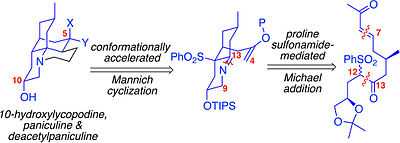10-Hydroxy Lycopodium alkaloids
The 10-hydroxy Lycopodium alkaloids, 10-hydroxylycopodine, deacetylpaniculine and paniculine, are a series of natural products isolated from a Chilean club moss Lycopodium confertum. Deacetylpaniculine and paniculine were also isolated from Lycopodium paniculatum.[1]
The Lycopodium alkaloids are of interest due to their biological activity and unique skeletal characteristics,[2] however, many compounds in this class have not been well studied.
Synthesis

The first enantioselective synthesis of 10-hydroxylycopodine, deacetylpaniculine and paniculine was published by Mrinmoy Saha and Professor Rich Carter in 2013 from Oregon State University. A common intermediate strategy was used to accomplish the total syntheses.[3] The key steps toward the syntheses are an organocatalyzed (Proline sulfonamide catalyst nicknamed as Hua Cat.) Michael reaction and a Zn (OTf)2 mediated conformationally accelerated Mannich reaction.
References
- ↑ Muñoz, Orlando M. (January 1990). "High Resolution NMR Studies of Paniculine and Related Lycopodium Compounds". Journal of Natural Products 53 (1): 200–203. doi:10.1021/np50067a032.
- ↑ "Lycopodine and the Lycopodium Alkaloids".
- ↑ Saha, Mrinmoy (February 2013). "Toward a Unified Approach for the Lycopodines: Synthesis of 10-Hydroxylycopodine, Deacetylpaniculine, and Paniculine". Organic Letters 15 (4): 736–739. doi:10.1021/ol303272w. PMC 3616490. PMID 23384410.